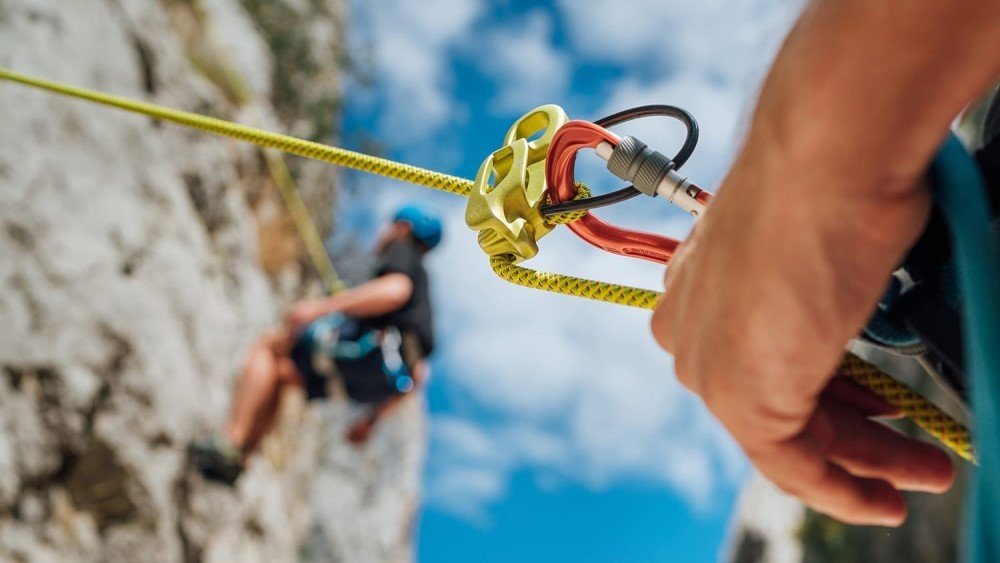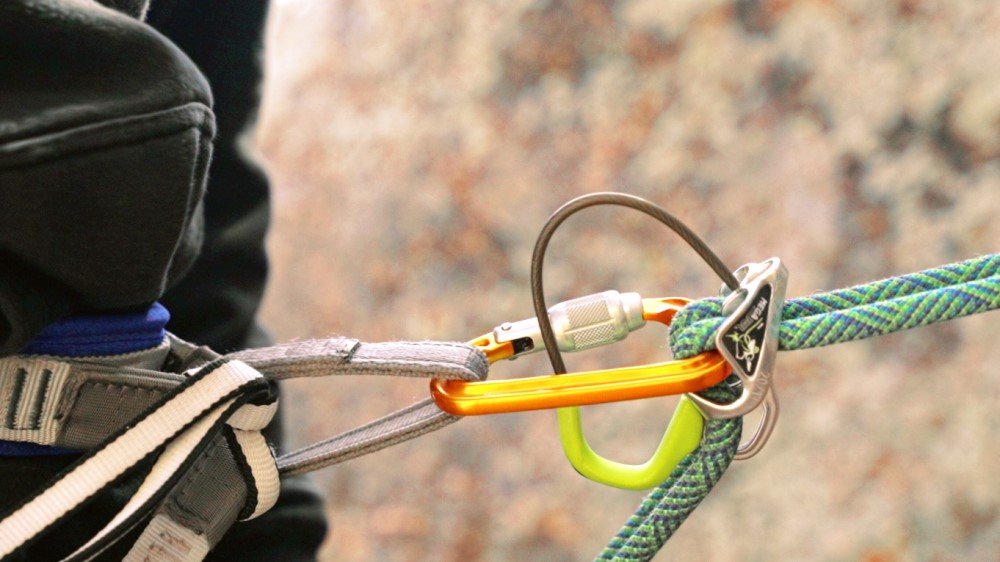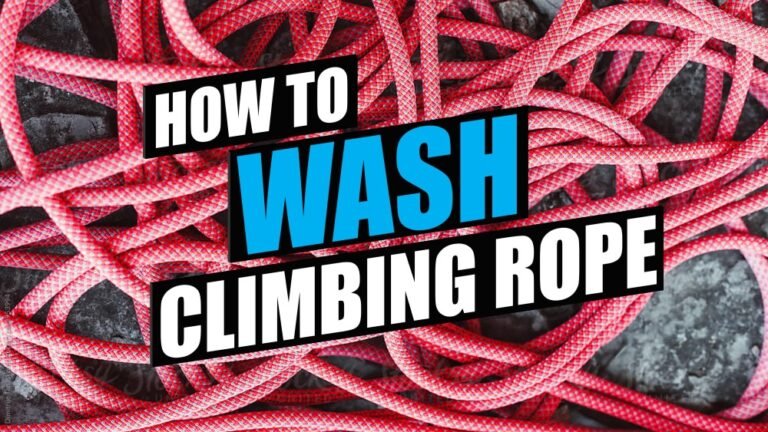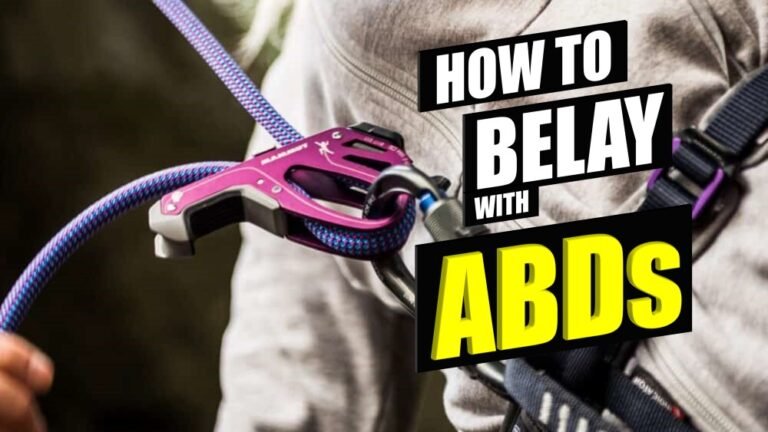How to belay safely with ABDs
Belaying, the pivotal safety technique in climbing, involves managing the rope to protect a climber from falls. Assisted belaying devices have revolutionized climbing safety, offering enhanced security and control. Whether you’re a seasoned climber or a beginner, mastering these devices is crucial for a safe and enjoyable climbing experience.
Belaying with a tube-style device and an assisted braking device (ABD) differs significantly in their mechanics and the level of assistance they provide to the belayer.
Tube-Style Belay Device:


Mechanism:
- Friction-Based: Tube-style devices, like ATCs (Air Traffic Controller), use friction generated by the rope passing through the device to create resistance. The belayer controls the friction by varying the angle of the rope and applying hand pressure to control the descent or arrest a fall.
Operation:
- Manual Control: The belayer has direct control over the rope’s movement by using their brake hand to regulate the speed of descent or stop a fall. It requires active and constant engagement from the belayer to ensure safety.
Assistance Level:
- Manual Dependence: The tube-style device requires the belayer to provide consistent and appropriate braking force throughout the climb. It doesn’t offer automatic locking or assisted braking features.
Assisted Braking Device (ABD):


Mechanism:
- Assisted Braking: ABDs, like GriGri, Giga Jul or Mammut Smart, have internal mechanisms that engage and lock the rope in case of a sudden increase in force or speed. They use cams or other braking mechanisms to automatically arrest a fall or control rope movement.
Operation:
- Assistance with Braking: These devices offer a level of assisted braking, reducing the need for the belayer to constantly apply manual braking force. However, the belayer still maintains control but with additional assistance from the device.
Assistance Level:
- Automatic Locking: ABDs provide an added layer of safety by automatically locking the rope when a sudden force is applied, such as during a fall. They significantly reduce the risk of human error but still require proper handling and vigilance from the belayer.
Key Differences:
- Control and Assistance: Tube-style devices rely entirely on the belayer’s manual control and intervention, while ABDs offer an additional layer of automatic assistance in arresting falls or controlling rope speed.
- Braking Mechanism: Tube-style devices depend solely on friction, whereas ABDs have internal mechanisms that assist in braking, providing added safety features.
- Level of Engagement: ABDs may reduce the physical strain on the belayer compared to tube-style devices, but both require attention and proper handling.
Both types of devices have their merits, and the choice between them often depends on personal preference, the climbing situation, and the level of comfort and experience of the belayer. However, regardless of the device used, proper training, understanding of the equipment, and vigilance are crucial for safe belaying.
Understanding Assisted Belaying Devices
Assisted belaying devices, such as GriGri, Eddy, or Click-Up, function as a mechanical brake, providing added security by arresting a fall or controlling the rope’s speed during descent. These devices are designed to assist the belayer by automatically locking the rope in case of sudden tension or acceleration.
Steps for Safe Belaying with Assisted Devices
1. Selecting the Right Device:
- Choose a device suitable for your climbing style and experience level. Read the manufacturer’s instructions thoroughly.
2. Inspecting the Equipment:
- Before climbing, examine the assisted belaying device for any damage or wear. Check the rope compatibility and ensure it’s within the device’s specifications.
3. Understanding Device Operation:
- Familiarize yourself with the device’s operation by practicing in a controlled environment. Learn how to feed the rope, arrest falls, and lower the climber smoothly.
4. Proper Setup:
- Attach the device correctly to your harness using a locking carabiner. Verify that the rope is threaded through the device according to the manufacturer’s instructions.
5. Effective Communication:
- Establish clear and concise communication with your climbing partner. Use standardized verbal commands for readiness, climbing, and lowering.
6. Maintain Constant Attention:
- Remain focused on the climber at all times. Avoid distractions and be ready to act swiftly in case of an unexpected fall or movement.
7. Backup Safety Measures:
- While assisted belaying devices enhance safety, maintaining proper hand positioning on the brake strand of the rope provides an added layer of security.
8. Practice and Training:
- Regularly practice belaying techniques using the assisted device. Attend training sessions or seek guidance from experienced climbers to refine your skills.
Common Mistakes to Avoid
- Inattentiveness: Never lose focus on the climber. Stay attentive and ready to react instantly to any situation.
- Improper Usage: Avoid using the device without proper understanding or trying to improvise techniques not recommended by the manufacturer.
- Neglecting Maintenance: Regularly inspect and maintain your assisted belaying device to ensure its optimal functioning.
Conclusion
Assisted belaying devices are invaluable tools that significantly enhance climbing safety, but they aren’t a substitute for proper training and attention. Mastering these devices involves practice, understanding their operation, and constant vigilance. Always prioritize safety, communicate effectively, and adhere to recommended practices to ensure a secure and enjoyable climbing experience for both you and your climbing partner.











